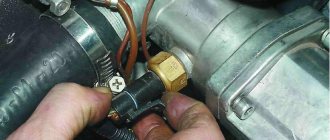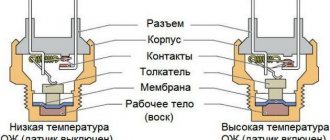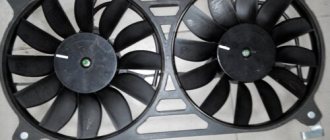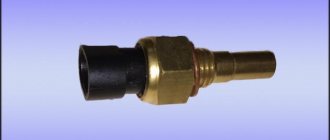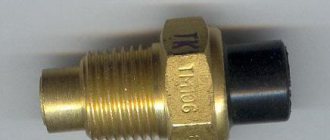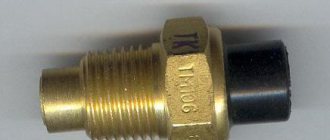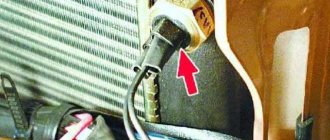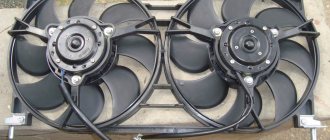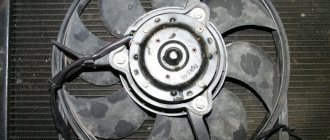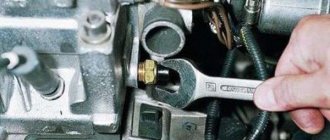Features of the Niva cooling system.
The VAZ-21214 engine cooling system is designed for off-road driving, that is, to operate for a long time at low speed and high revs.
This causes the engine to become very hot. Therefore, the Nivas are equipped with a cooling radiator slightly larger than on the classics and two cooling fans. In fact, the machines are operated mainly in urban environments, where the engine operates without overload and the operation of two fans to cool the radiator is practically not needed. In addition, when operating, the Niva cooling fan makes quite a bit of noise, which affects comfort.
Description of the Niva fan circuit.
In the factory circuit, the fans are connected in parallel to each other, and switching on is carried out automatically through two relays. Automatic activation depends on the engine type. On a carburetor engine, activation is carried out by a sensor mounted on the radiator. The temperature in this case depends on the response temperature of the sensor indicated on the housing. On an injection engine, the fans are turned on by the engine control unit when the temperature recorded in the control program is reached.
Throttle Position Sensor (TPS)
The TPS is installed on the throttle itself and is a potentiometer. This sensor reads readings from the throttle position and transmits them to the ECU. The damper opens access to air, thereby increasing engine speed. When the damper opens, the sensor sends a signal to the control unit to increase the fuel supply, which is necessary to form a working air-fuel mixture.
The sensor that most often fails is an unreliable element of the system. Subsequently, they abandoned it and switched to an electronic throttle.
Signs of a malfunction of the TPS:
- High speed at start-up;
- Jumps in engine speed;
- Increased fuel consumption;
- Not smooth idle;
Fan malfunctions
Let's look at what malfunctions of the Niva cooling fan may occur and how to identify them. The most common malfunction is blown fuses.
The fuse blows.
A single occurrence of such a malfunction does not indicate a faulty wiring or the fans themselves. During operation, fuses heat up and eventually fail. They are easy enough to replace. They are located on a carburetor car in the lower fuse block, and on an injection car in an additional block near the driver's door pillar.
If the fuses blow immediately when the fans are turned on, then it is necessary to find a short circuit or replace the fan. To determine the location of the malfunction, it is enough to disconnect the connector on the fan motor and connect the wires on the radiator sensor with each other with the ignition on.
On an injection engine, to check it is necessary to remove the chip from the temperature sensor, which is located on the thermostat. In this case, the engine control unit will go into emergency mode and activate a program for working with a faulty temperature sensor and turn on the fan relay. If the fuse burns out, then it is necessary to find and eliminate the short circuit. If the fuse remains intact, then the problem is most likely in the fan motor. Faulty fans are stuck or difficult to rotate. This may be caused by the stator magnet falling off or the armature bushings wearing out. A faulty fan should be replaced.
The fan does not turn on
Another common malfunction is when the fan does not turn on when the operating temperature is reached. The reason may be a malfunction of the fan sensor on a carburetor car or the engine control unit on an injection car, a relay malfunction, broken wires, or a malfunction of the fan motor.
It is better to start troubleshooting by checking the temperature sensor or control unit. This is done as described earlier by bridging the wires on the carburetor engine sensor or removing the chip from the temperature sensor on the injection engine. If the fans do not work, then you need to check the power relay.
The relays are located under the instrument panel on the front wall. To check, remove the chip from the relay and check for the presence of power at pins 30 and 85. If there is no power, check the condition of the fuse and wires. If there is power, connect terminals 86 and 85 of the relay with a test lamp. If the warning lamp does not light up, then the wire from the ECU connector to the relay socket is broken or the ECU itself is faulty. A lit lamp indicates a relay malfunction.
To test the relay, connect pins 87 and 30 with a piece of copper wire, which should trigger the fans. If this does not happen, then connect a test lamp to the connector without removing the jumper from the relay connector. If the lamp does not light up, then connect one end of the test lamp to the housing, and with the other, check for the presence of a plus on the connector. If the control lamp does not light up, then there is a break in the wire from the relay to the fan connector. Accordingly, the glow of the lamp indicates poor contact of the negative wire with the body or a wire break. The presence of power and minus indicates a malfunction of the electric motor.
If the fan starts working when the relay terminals are bridged, it is necessary to check the condition of the wires connecting the temperature sensor or the engine control unit, depending on the type of engine.
Source
Oil pressure sensor (OPS)
The oil pressure sensor is located on the right side of the cylinder block and is screwed into the oil line fitting. This sensor is necessary to monitor the oil pressure in the engine. As you know, operating a car with low oil pressure in the internal combustion engine can damage it. When the oil pressure in the internal combustion engine decreases, the sensor closes the contact and sends a signal to the Niva instrument panel, lighting up the oil pressure indicator in the form of a red oil can.
Signs of DDM malfunction:
- Constant lighting of the oil pressure lamp;
- Oil leak from the sensor junction;
Cooling fans do not work Niva 21214 injector
The connection diagram for Niva VAZ-21214 fans is identical to the diagram for other cars of the VAZ family. The only difference is the presence of two fans, which are turned on using two relays. This is caused by the engine working under heavy loads when driving off-road. In city conditions this is practically not necessary, with the possible exception of driving in traffic jams in hot weather. When turned on, fans create some discomfort as they make noise. You can reduce noise by reducing the rotation speed of the electric motors or turning off one of the fans. In the second case, the second fan can be turned on forcibly using a button or key.
Niva 21214 cooling fans do not turn on. Connecting Niva fans
Therefore, the Nivas are equipped with a cooling radiator slightly larger than on the classics and two cooling fans. In fact, the cars are operated mainly in urban environments, where the engine operates without overload and the operation of two fans to cool the radiator is practically not needed. In addition, when operating, the Niva cooling fan makes quite a bit of noise, which affects comfort. In the factory circuit, the fans are connected in parallel to each other, and switching on is carried out automatically through two relays.
depends on the engine type. On a carburetor engine, activation is carried out by a sensor installed on the radiator.
The temperature in this case depends on the response temperature of the sensor indicated on the housing. On an injection engine, the fans are turned on by the engine control unit when the temperature recorded in the control program is reached. Let's consider what malfunctions of the Niva cooling fan may occur and how to identify them.
The most common malfunction is blown fuses. A single occurrence of such a malfunction does not indicate a faulty wiring or the fans themselves. During operation, fuses heat up and eventually fail. They are easy enough to replace.
They are located on a carburetor car in the lower fuse block, and on an injection car in an additional block near the driver's door pillar. If the fuses blow directly when the fans are turned on, then it is necessary to find or replace the fan. To determine the location of the malfunction, it is enough to disconnect the chip on the fan electric motor and connect the wires on the radiator sensor with the ignition on. On an injection engine, to check, you need to remove the chip from the temperature sensor, which is located on the thermostat. In this case, the engine control unit will go into and activate a program for working with the faulty temperature sensor and turn on the fan relay.
If the fuse burns out, then it is necessary to find and eliminate the short circuit. If the fuse remains intact, then the problem is most likely in the fan motor.
Phase sensor (PF)
The phase sensor, also known as the camshaft position sensor, is installed in the cylinder head plug. Designed for phased fuel injection. Reads readings from the camshaft and transmits them to the computer; these readings are necessary for accurate distribution of the fuel mixture between the cylinders.
Signs of DF malfunction:
- Increased fuel consumption;
- Increased engine vibrations;
Sensor for turning on electric fans. — Lada 4×4 3D, 1.8 l., 2000 on DRIVE2
There are many opinions on the Internet about where to install a coolant temperature sensor to turn on electric fans. Basically, people are divided into two camps before the radiator and after the radiator, although there are ways to install a thermostat and in the radiator. For both, everything seems to work. After analyzing the whole situation, I came to the conclusion that it doesn’t matter where you put it, it’s not so much the large cooling system in our engines, and the main job of regulating the temperature in the engine is done by the thermostat, and the liquid circulates in a small circle. When the engine heats up, the hot liquid will flow through the opened thermostat into the radiator, and From the radiator, cooler fluid will flow into the engine, and as soon as cold fluid enters the engine, the thermostat will close. The fans will turn on in any case as soon as the liquid in the radiator becomes hot, and it doesn’t matter before or after the sensor is installed, the difference in turning on will be seconds. If the sensor is positioned before, then the fans will turn on earlier and begin to cool the temperature of the liquid already in the radiator to an even lower temperature. immediately goes to cooling the engine, the thermostat slammed shut, the fans still worked a little, cooled the liquid entering the radiator a little and turned off. If the sensor is located after the radiator, then the fans turn on later than with the sensor before the radiator option, but the liquid will not go into the engine with such a big difference temperature and cooling of the engine turns out to be longer. The liquid will be cooled all at once both in the block and in the radiator to the same temperature, the thermostat slams shut, and the fans turn off at the same moment. However, in terms of cooling time and energy consumption, the result is the same Of course, maybe I’m wrong.
Here is a video of how the fans work by time, the heat outside is over 30 degrees, I stood in the sun, there is no wind.
Oxygen sensor (DC, lambda probe)
An oxygen sensor, also known as a lambda probe, is installed in the exhaust system of a car. In some versions of cars, two sensors are installed before the catalyst and after the catalyst. Two sensors are installed in Niva with EURO-4 standards. The sensor captures exhaust gases and transmits readings to the ECU. If there is a large amount of unburned gasoline in the exhaust gases or, on the contrary, a small amount, then the DC makes changes to adjust the fuel mixture.
Signs of DC malfunction:
- Increased fuel consumption;
- Loss of vehicle dynamics;
- Poor engine starting;
Cooling fan Niva 21214 does not turn off.
Connecting Niva fans
This is why the serviceability of the components and elements of the cooling circuit is so important. In order to be able to service them and identify malfunctions, you need to understand what the circuit consists of and how the Niva’s cooling functions. The cooling system of the VAZ Niva is quite effective and has undergone virtually no changes since its creation.
It includes the following units and elements:
It is connected to a controller that cooks depending on the heating of the power unit and turns on the fans. There are 2 more differences in the cooling design of engines with a carburetor and an injector:
In VAZ-2131 cars, the cooling system is generally similar to a regular Niva with an injector.
The VAZ-2131 heater radiator is not equipped with a tap, which is why antifreeze flows through it all year round. The Niva's cooling circuit operates under pressure, since in normal mode it does not communicate with the atmosphere.
It also boils at an elevated temperature, +110 °C. The key element in the operation of the system is the thermostatic valve, which distributes fluid flows depending on the heating of the engine. Inside the thermostat there is a damper controlled by a temperature-sensitive element.
When heated, it moves the damper, opening another path for the flow. In general, the scheme works according to the following algorithm:
The cooling fan turns on on a cold engine: the main reasons and solution to the problem
Modern cars use a combined cooling system: liquid and air cooling.
By liquid we should understand circulation through special channels in and around the engine.
The specified fan is activated when the heating of the unit is sufficiently high. However, quite often drivers are faced with the question of why the cooling fan turns on on a cold engine, the engine fan turns on in winter or spins constantly. In this article we will talk about the reasons why the cooling fan operates on a cold engine, the engine cooling fan does not turn off, or the specified fan does not work correctly.
Let's start with the fact that this problem can clearly indicate both a malfunction of the liquid cooling system and a malfunction of the fan itself. In any case, we are talking about a breakdown that cannot be ignored, since the risk of overheating of the internal combustion engine significantly increases. For a better understanding, it is necessary to superficially consider the principle of operation of the fan on most modern cars.
So, after heating the coolant to an average temperature of about 100 degrees Celsius, the sensor or control unit closes the electrical circuit. After this, the fan turns on, improving engine cooling. When the coolant temperature drops to the required value, the circuit opens and the blowing stops.
We also note that in cases where the control unit detects errors in the cooling system, the fan can spin immediately after turning on the ignition, even on a cold internal combustion engine.
To erase an error from the ECU, on some models it is enough to remove the terminal from the battery for a couple of minutes, while on others the reset is carried out using diagnostic equipment.
Possible reasons
Fuses and relays Niva 21214 injector
Before repairing or replacing the cooling fan on a Chevrolet Niva, it is necessary, as already noted, to understand the reasons why this problem could occur. The first step is to inspect the front panel fuse. As a rule, it is located in the mounting block, on the passenger seat side. Two fuses take part in the air cooling process. At the same time, if the right one breaks down, both stop functioning, and if the left one breaks down, the right one still works.
The mounting block contains three relays. Each of them is responsible for a different speed of the cooling fan. If the low speed relay burns out, then the fan only works at maximum power. At the same time, by setting it to a low speed, it will heat up. There is also another additional fuse in the car that supplies power to the relay. If it malfunctions, the entire system will fail completely.
If the temperature sensor breaks, the cooling fan will also not work. Such sensors are installed directly on the engine itself. The first one comes into operation when the air temperature reaches 90 °C, and the second - at 101 °C. When diagnosing a fan failure, most often the inspection begins with them. To do this, you need to disconnect the connector from the electric motor and supply power to them through the battery. If the electric motor eventually starts, the sensors have failed.
If, as a result of checking the fuse, sensor and relay, no damage is detected, then proceed to inspecting the fans themselves. When checking them, their motor connectors are disconnected, and the voltage supply wires are connected to the lamp. We do the same scheme with the sensor. If the lamps end up glowing, then the fans are undoubtedly broken.
If the temperature in the engine compartment is too high, the plastic fan casings become deformed. If you start the fan in this state, its blades will begin to cling to the casing, which can cause the blade to heat up and subsequently melt. If you turn off the system after they melt, they will stick to the casing and will not start at all in the future.
Another very common problem is cold antifreeze. If there is cold antifreeze in the system and the ignition is already started, then the fans simply will not work. Most often this problem occurs due to:
- failure of the ECM controller;
- stuck fan relay contacts;
- loss of contacts of the pads or wiring harness that go to the controller from the temperature sensor.
Removing idle fans is very simple and quick:
- all wires are disconnected;
- the upper pipes are removed;
- the bumper is pulled out;
- if there is an air conditioner, the tubes are carefully removed, the freon is drained (the material is not cheap, so it is better to collect it in a clean container in order to later return it to its place);
- the air conditioning radiator is removed;
- the fastenings on the radiator casing become loose;
- the cooling fan unit is removed from the radiator at an angle;
- the bolts securing the block are disconnected, after which it is pulled out.
Niva 21214 malfunction fan constantly running
Azat Galiev Hello Andrey encountered the following problem: the left fan (on the driver’s side) does not turn on; the screw connected directly is fine, but the right one turns on at 100+, what could be the problem? matte 159 rus Hello, forgive me for contacting me so often for some reason at one point 1 fan did not turn off and continued to work for 30 minutes, I turned off the car, removed the terminal, it still did not turn off, and when I turned it off, it continued to work, while the terminal was turning it off, I pulled out a fuse it stalled, then waited for about 15 minutes, inserted the fuse, the fan started working again, turned the ignition key, the fan stopped working, didn’t understand anything, drove on with the “NIVA URBAN” (for sale if anything :).) Hello. Thank you very much for your work! For me, as a beginner nivavodka, this is invaluable knowledge.
Important If insulation is installed, the engine will not be able to cool effectively.
This may be the answer to the question of why the radiator cooling fan is constantly running. But this is a fairly rare reason.
So, among the most popular reasons why a fan is unstable are problems with electronics. This is exactly what most car owners complain about on specialized forums.
Many solve this problem by replacing the sensor and fuses. And it helps. In half of the cases, the issue can be resolved by replacing the thermostat.
Info The situation can also be improved by cleaning the radiator.
Problems happen on any car; this topic worries Ford Focus car owners. The cooling fan runs constantly on luxury cars as well.
It is important to notice this problem in time, otherwise it can lead to disastrous consequences.
This feature is found only on some models and is, in fact, protection against overheating of the power unit, since a constantly running fan reduces the temperature.
The cooling fan of the VAZ 21214 often turns on.
Niva cooling fan
Radiator cooling fans VAZ NIVA. Fan switching temperature +95+98 degrees. The duration of operation of the fans depends on the temperature and condition (serviceability of all components) of the engine cooling system.
If the fans do not work normally for a long time, then, if necessary, you can find the reason. I talked about this in previous videos.
Links below in the description: How to remove VAZ NIVA.
Correctly removing the air lock of the VAZ NIVA Checking the thermostat of the VAZ NIVA without removing it. Choosing a VAZ NIVA thermostat All signs of a broken VAZ NIVA.
At all stages of head gasket failure Signs of a pump malfunction. Choosing a VAZ pump. VAZ NIVA pump design. All reasons for engine overheating and boiling.
Eliminating the causes of overheating of the VAZ NIVA engine in detail.
They don’t seem to buzz as loudly as our 2131.
When ours howls, you can hear it a kilometer away. True, judging by the dashboard, your car is older than ours (ours is 2013), but your fans are also electric and visually similar to those on our Niva. Have you encountered such a situation? Ruslan Rinatovich respect to the niva drivers) Alexander Bondarenko Oh, these fans are disgusting, they howl so that you immediately understand that somewhere in a traffic jam a Niva is driving, and how they attract the attention of the neighbors downstream.
They all howl the same way, it’s just that from the video it seems quieter. But this is the question I have in the M-ka 2014: when I fill up with fuel, the arrow does not reach the maximum when the tank is full, is this the case for everyone? Another question is when half or a quarter of the gasoline is filled, the smell of gasoline appears in the cabin, but it is not obvious, but with a full tank everything is normal and there are no odors. Kristina Shagazizova Niva21214 2000, Fans work without noise.
Why. So what switch-on temperature is considered correct and safe for the engine. On the bookmaker you can set at least 90. max crap Thanks Andrey. Yesterday I tested the Niva off-road) the fans work, they turn on only when the needle approaches 130, and somehow quickly turn off, literally 40 seconds and that’s it.
When is the next video)? Andrey Lapochkin For +gruzchik79. Hello. The operating temperature is +90C, but the fans should be turned on according to the standard at +95+98C - this is for more complete combustion of fuel.
For materials, the safest engine temperature is generally +85C. Set it to +85C, only if your thermostat opens at +87C, then why should the fans turn on at +85? And +90C is too early. At 2112 at +101C it turns on and at 97-98 it turns off.
Ignition module (IZ)
The ignition module is installed on the left side of the engine on a bracket. This sensor is involved in the formation of ignition. It is this that produces the high-voltage voltage necessary to create a spark in the combustion chamber of the internal combustion engine. The module has two coils, they are also autotransformers, which produce a spark in pairs, each coil for two cylinders. If one of the coils fails, two cylinders fail at once.
Signs of malfunction of the MH:
- Troubles the engine;
- Increased fuel consumption;
- Increased engine vibrations;
- Loss of traction and dynamics;
Niva 21214 fan does not turn on
LiteZona.ru 08.08.2021 AvtoVAZ Contents
When relay 2 was turned on, the right fan (in front of the passenger who is standing) turned on, but it turned on at full blast, that is, with the sound of a “plane taking off”! I began to rack my brains - what to do... I first called the OD in Podolsk (AvtoRus) - and they no longer OD Lada since January 1... Oops! I described the problem - they say we don’t know, we need to look... I ask where the relays are - I don’t know the answer, to be honest, I’m not good at Niva... I say, well, you can drive up (purely for fun) - we’re all booked for today, for tomorrow and the day after tomorrow too It’s not a fact that there is a recording... Well, okay then! I’m calling MosNiva at 1st Botkinsky Prospect, 7A (I’ve never been, but I already like them) - by phone!
I outline the situation and the answer was - the connector on the fan was rotten - 99% I give!
In response to my objections - they say the car is not a year old, the mileage is only 15,000 km - they say - but look and see for yourself))) SO IT HAPPENED! Fuck, this is what I saw 20 seconds after talking with the guy from MosNiva - I’m trying to get the connector out myself, but I need to take off the protection and restore the connection of the wires from below... It’s cold outside, I’ve been outside for a long time, my fingers are frozen everywhere, my face is already frozen from the wind... I decide to try my luck, I call the Compass service, which is in Podolsk, just 5 minutes from home - the electrician is free, hurray, I rush to him! Nivka and I end up in a warm box, oh how good it is to tinker with the car in the warmth! We choose the most optimal solution in our opinion - bend the radiator a little in order to pull out the terminals from there, or either lie on the floor to remove the protection, or remove the radiators from the mounts - there are two of them... - it turned out pretty decent, although it’s a shame for the radiator is a little bit - That's the way it is, guys... It's a shame about the quality of the parts, especially those responsible for cooling the engine! I'm running to the store across the street for wires, heat shrink and electrical tape.
One fan on the Niva does not work
Friends, tell me the algorithm for the operation of fans on an injection field. There are already two of them. 0
Or maybe the sensor is faulty and therefore not turned on.
The first is something around 100g, the second is somewhere around 102-108. Depends on the control unit. The cooling system must be sealed. Operates under pressure up to 1 atm.
? Start checking from the fan itself and further along the circuit.
and there is a reletna to each his own? 0
I had a similar rake on my Priora.
The problem was in the relay of one (smaller) fan; the computer complained about this, showing error 691 (not critical, the light does not light up). I changed the relay and everything became normal. It’s generally not clear how it’s done - the fans have two speeds, and when you turn on the air conditioner, they start to thresh slowly, regardless of the temperature (this seems to be a feature of all air conditioners).
ded bocar, This happened to a friend of mine. After replacing the temperature sensor, the screws started working!
In your case, most likely the sensor also failed. 0
I just looked at the wiring diagram of the VAZ21214 and they are messed up with each other 0
The radiator cap needs to be replaced. The one with the valve.
I downloaded the correct diagram tomorrow I'll dig around 0
ded bocar, do not forget to pay attention to the cleanliness of the radiator honeycombs, blow them with compressed air.
Radiator cooling fan
The air cooling system is structurally simpler, since it includes only a turbine with an impeller driven by a belt from the crankshaft.
This turbine operates continuously as long as the crankshaft rotates.
It supplies air to the engine cylinders, cooling them. For better cooling, the cylinders have special fins.
the design is much more complicated, but it is more efficient and better maintains the temperature regime. It consists of a cooling jacket through which liquid circulates. To ensure circulation, the design includes a water pump driven by a belt or chain drive from the crankshaft.
The design also includes a thermostat, which ensures the movement of liquid in two so-called circles. One of the circles is small, in which the liquid moves only through the cooling jacket and the interior heating system. This circle is needed to quickly heat the liquid to the desired temperature.
As soon as the temperature reaches a certain value, the thermostat redirects the liquid through a large circle, which also includes a radiator, where the excessively heated liquid is cooled.
But the liquid air system cannot do without air flow. It is air that cools the liquid in the radiator. When the car moves, the air flow passes through the radiator honeycombs and removes heat.
The air entering the engine compartment also further cools the engine. But there are times when the flow of this air is insufficient to remove heat, for example, this could be if the engine is running, but the car is not moving. And the engine should not be allowed to overheat, as this can lead to serious problems.
Their engine has a longitudinal arrangement, so the water pump is located in front and is driven by a belt from the crankshaft. An impeller is attached to the pump itself, which provides air flow to the radiator. Since the rotation of the pump must be constant, the fan supplies air all the time.
Some cars use a mechanical fan drive, but additionally there is a clutch that allows you to turn off the fan itself, while the water pump continues to operate normally.
On passenger cars, an electrically driven cooling fan is more often used. To put it simply, such a device is simply a 12-volt electric motor with an impeller attached to its rotor.
Installing additional radiator fans on a Gazelle
Design and principle of operation
The designers of the Chevrolet Niva used a dual fan unit in the cooling system. This slightly complicated the connection diagram, but sharply increased the efficiency of radiator airflow. The fans are driven by 12-volt DC synchronous motors with a permanent magnet inductor. Electric motors have a closed, non-demountable design and do not require maintenance.
The power of each electric motor is 110 W. The fan assembly draws 18 amps.
The fans are turned on one by one using an electromagnetic relay controlled by the on-board computer. When the coolant heats up above 99 degrees, the electric fan located closer to the engine air intake starts. The switch-on temperature of the second impeller is 101 degrees. The fan connection diagram is shown below.
The fan power system includes three relays and a resistor, which, if necessary, provides a reduced rotation speed of the first motor. Power is supplied from the battery through fuses that save the wiring and battery in the event of a short circuit. Control signals come from pins 29 and 68 of the motor controller.
The fans automatically turn off when the antifreeze cools to 95 degrees.
Consecutive switching on and off of engines reduces the load on the on-board electrical network. In most cases, it is possible to normalize the temperature only with the help of the first fan. This is especially useful when driving at night, when headlights and side lights put a lot of stress on the generator.
Purpose and design
This is a module designed to be included in the on-board circuit of a motor that consumes high current. The fan motor is powered by electricity with a current of 20-35A, which is unacceptable for inclusion in a low-voltage control system - the wiring will melt. The Niva has only three relays, two for the left and right fans separately and one common. Each device has its own number in the on-board network. The principle of operation and purpose of the relay is relevant for cars of all types 2004, 2010, 2022 and other years of production.
Inside, the relays have an identical design. There is a low part, a transformer and a high part. Also two pairs of contacts, one normally closed, the second open. When a pulse is applied to the lower part, a magnetic field is formed on the windings, and the contact group on the high side closes - power is supplied to the fan motor.
The cooling screw operates in two modes. When the engine heats up to 99 degrees Celsius, the first fan is turned on, after passing the 101⁰C mark, the second one is connected. If the system cannot cope, the motors switch to higher speeds.
Fan relay diagram
The figure shows the power supply circuit for the electric fans of the cooling system of the installation. Design elements are presented by numbers.
- 1/7 – left and right fan motors;
- 2 – additional power relay;
- 3 – fuse;
- 4 – power controller;
- 5 – auxiliary resistor;
- 6/8 – main relay for turning on the right and left electric motor, respectively;
- A/C – negative/positive battery terminal;
- B – to the main ignition relay.
One fan does not work on Niva 21214
Comrades, tell me Niva 21214 2004 year engineer, one fan does not work, if on the driver's side the left one, changed the temp sensor. cool liquid, temp. sensor on the tidy, two relays, fuses of course, and the fan itself is new 163
(modified) 48 minutes ago, Art said: on the driver’s side, this is the first one, it’s not so revving, but the constant work of blowing comes to it, it turns on/off, and the second one only at critical temperatures, when the first one can’t cope, then the high-speed one turns on so that to prevent overheating, and how to control the first one, if it doesn’t work, the protection, so to speak, is programmed to turn on in the required range. Connect the computer and test the turn-on from the computer, if it doesn’t turn on, but the screw itself works directly from the battery, so look in the wires.
Modified March 15, 2022 by Palestinian 18
like when I’m slipping or in a traffic jam it will work when the load is 18
I remove the temperature sensor, still one fan works, my brain does not give the command 163
1 minute ago, Art said: I don’t remember exactly, but it seems from the factory that the first one is turned on with 97 and 93 is turned off and the second is turned on 103-105 if I’m not mistaken. The second high-speed screw is, as already written, help for the first if it doesn’t cope and protection against overheating if the first one died. Although you can put them to work in pairs, in short, it depends on who has what idea. 163
2 minutes ago, Art said: This may be the case, the controller cable is to be checked and before that the check from the computer is connected, then the test will show. 18
How the fans on the Niva 21214 are turned on.
Niva cooling fan
When turned on, fans create some discomfort as they make noise. You can reduce noise by reducing the rotation speed of the electric motors or turning off one of the fans. In the second case, the second fan can be turned on forcibly using a button or key. Methods for connecting fans. There are two ways to reduce the rotation speed of the fan motors.
The first is to connect an additional resistance of sufficient power in series with each fan motor. The second way is to connect Niva fans in series. The disadvantage in the first case is the search for resistance, which will also heat up.
In the second case, a minimum of alterations are required.
It is enough to pull out the negative wire from the connector of the first fan, and the positive wire from the second connector. After this, connect the free terminals on the motors with a wire of the appropriate cross-section.
But in this case, in order to turn on the fans at high speeds, you will need to redo everything back. If you want the fans to be able to operate at low and high speeds depending on the heating of the engine, then you will need to install an additional relay that will switch the fans from serial to parallel connection . This relay can be controlled manually or automatically. You can also combine both control methods.
The design of the Niva fan connection diagram can be different, depending on the type of engine and your preferences. For manual switching, you need to install a switch, a key is best, and for automatic
